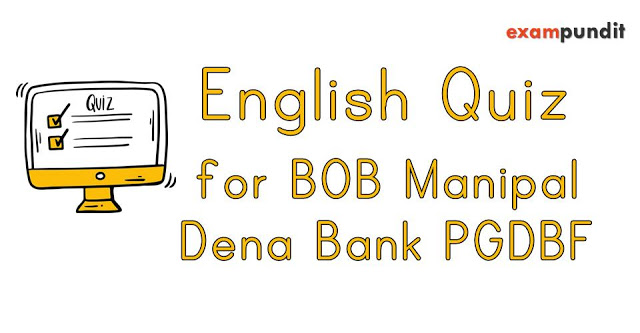Hello and welcome to exampundit. Here is a set of English Quiz for BOB Manipal and Dena Bank PGDBF 2017.
Advertisement
(adsbygoogle = window.adsbygoogle || []).push({});
Directions (Q. 1-10) : Read the
following passage carefully and answer the questions. Certain words/phrases
have been given in bold to help you locate them while answering some of the
questions.
following passage carefully and answer the questions. Certain words/phrases
have been given in bold to help you locate them while answering some of the
questions.
The Indian government has set an
ambitious target of generating 100GW of energy from solar energy sources and
60GW from wind energy sources by 2022. As of March 31, 2016, the corresponding
figures stood at 6.76GW and 26.7GW respectively. Unfortunately, renewable
energy is more capital-intensive than coal, and financing this will require
$160 billion of capital,$120 billion as debt, and $40 billion as
equity.Currently, most renewable projects are financed by bank commercial loans
at 11-12 percent interest per annum. The Indian banking sector is currently
going through a balance sheet adjustment; banks are unlikely to be able to
expand their balance sheets to be able to finance the additional requirements
of the renewable sector. Green bonds may be able to fill this gap.A green bond
is a fixed income inctrement for the purpose of raising debt capital through
markets. It certifies that the proceeds will be used exclusively for specific
“green” purposes. The Green Bond Principles are voluntary guidelines
issued by the International Capital Market Association which states the
procedure for certifying a green bond. These encompass the use of proceeds, the evaluation procedure, the
management of proceeds, and financial reporting. These guidelines are lacking
in specifics, leading to a lack of consensus
on what classifies as a green bond. Green bonds can provide a long-term source
of debt capital for renewable infrastructure projects. Since the cost of debt
availed for projects is higher than the yield for investment-grade bonds, it
may be possible to reduce the cost of capital for green infrastructure financed
or refinanced by bonds. While green bonds can facilitate the flow of capital to
low carbon infrastructure investments, the demand for such investment is driven
by low-carbon policy mandates. An enabling policy context is therefore vital
for the success of green bonds.
ambitious target of generating 100GW of energy from solar energy sources and
60GW from wind energy sources by 2022. As of March 31, 2016, the corresponding
figures stood at 6.76GW and 26.7GW respectively. Unfortunately, renewable
energy is more capital-intensive than coal, and financing this will require
$160 billion of capital,$120 billion as debt, and $40 billion as
equity.Currently, most renewable projects are financed by bank commercial loans
at 11-12 percent interest per annum. The Indian banking sector is currently
going through a balance sheet adjustment; banks are unlikely to be able to
expand their balance sheets to be able to finance the additional requirements
of the renewable sector. Green bonds may be able to fill this gap.A green bond
is a fixed income inctrement for the purpose of raising debt capital through
markets. It certifies that the proceeds will be used exclusively for specific
“green” purposes. The Green Bond Principles are voluntary guidelines
issued by the International Capital Market Association which states the
procedure for certifying a green bond. These encompass the use of proceeds, the evaluation procedure, the
management of proceeds, and financial reporting. These guidelines are lacking
in specifics, leading to a lack of consensus
on what classifies as a green bond. Green bonds can provide a long-term source
of debt capital for renewable infrastructure projects. Since the cost of debt
availed for projects is higher than the yield for investment-grade bonds, it
may be possible to reduce the cost of capital for green infrastructure financed
or refinanced by bonds. While green bonds can facilitate the flow of capital to
low carbon infrastructure investments, the demand for such investment is driven
by low-carbon policy mandates. An enabling policy context is therefore vital
for the success of green bonds.
There are many ways by which the
government currently provides subsidies for green projects. The first is
through accelerated depreciation
provisions, whereby capital expenditure is allowed to be depriciated by 80 per
cent in the first year and the remaining in the following five years. Feed-in
tariffs are long term contracts with discoms to purchase power from a renewable
project, usually at higher rates. A viability gap funding is a capital grant
from the government that bridges the gap between projects cost under the
prevailing electricity rate and the price quoted by the developer. Under a
generation-based incentive, the governnent provides ` 0.5/kWh ( kilo-watt hour)
supplied to the grid, subject to a cumulative maximum of `10 million/MW. The
incentive must be drawn over a minimum of four years and a maximum of 10 years.
Under renewable purchase obligations, the National Action Plan on Climate
Change (NAPCC) has set an ambitious RPO target of 15 per cent by 2020. Green
bonds would enable investor diversification,
mitigate risks since the repayment is tied to the issuer only, build a
community of green investors and enable refinancing bank loans at a lower cost.
Assets under management by signatories Responsible to the UN- supported
Principles for Responsilble Investment (PRI) are around $60 trillion so far,
and an increasing number of institutional investors and financial institutions
globally are publicly pledging to increase their green bond holdings. Since
February 2015, some banks and companies too have raised funds via green bonds.
Currently, there is no pricing advantage for banks in issuing green bonds and
likewise to the borrowers whose projects were invested in. Green bonds have
been around for a decade but regulation and investment in them is still
minuscule compared to the total market for debt mainly on account of lack of
green bond standards, low credit rating of potential issuers, and higher cost
of issuance. Considering that fossil fuels have enjoyed huge subsidies
throughout their history (namely, subsidies diesel, kerosene and gas) and have
contributed to environmental degradation and global warming, it is apt that clean
energy initiatives get equitable treatment. In order to develop a green bond
market, the government essentially needs to increase the funds available for
investment in green projects, by providing for specific tax incentives and
development of long term finance markets in general . Some of the key
actionable steps would be changing Insurance Regulatory and Development
Authority norms for size of investment for insurance companies, creating
mandates for provident funds to invest in infrastructure and environmentally
sustainable projects, increasing the priority sector lending limit for bank
loans under solar energy from a meagre `15 crore, standardising the definition
of green to be able to target government efforts in the direction, and
mobilising retail savings by way of tax exemption on the lines of Section
80CCF. Though the market is nascent,
broad guidelines are coming to the fore. As the market matures, investors will
require that green bond issuers report on status of deployments and
environmental outcomes of the investments. For the green bond market to have
long-term credibility investors and governments would need evidence that the
projects funded have in fact delivered the intended environmental benefits. The
Indian government can lead the global push towards green by taking three steps
to reduce our races’ carbon footprint: standardise “green” bonds as a
way to finance environmentally sustainable projects, provide incentives to
investing in projects funded by a carbon tax on polluting sources of energy
and, finally increase funds channelled towards investing in environmentally
sustainable projects.
government currently provides subsidies for green projects. The first is
through accelerated depreciation
provisions, whereby capital expenditure is allowed to be depriciated by 80 per
cent in the first year and the remaining in the following five years. Feed-in
tariffs are long term contracts with discoms to purchase power from a renewable
project, usually at higher rates. A viability gap funding is a capital grant
from the government that bridges the gap between projects cost under the
prevailing electricity rate and the price quoted by the developer. Under a
generation-based incentive, the governnent provides ` 0.5/kWh ( kilo-watt hour)
supplied to the grid, subject to a cumulative maximum of `10 million/MW. The
incentive must be drawn over a minimum of four years and a maximum of 10 years.
Under renewable purchase obligations, the National Action Plan on Climate
Change (NAPCC) has set an ambitious RPO target of 15 per cent by 2020. Green
bonds would enable investor diversification,
mitigate risks since the repayment is tied to the issuer only, build a
community of green investors and enable refinancing bank loans at a lower cost.
Assets under management by signatories Responsible to the UN- supported
Principles for Responsilble Investment (PRI) are around $60 trillion so far,
and an increasing number of institutional investors and financial institutions
globally are publicly pledging to increase their green bond holdings. Since
February 2015, some banks and companies too have raised funds via green bonds.
Currently, there is no pricing advantage for banks in issuing green bonds and
likewise to the borrowers whose projects were invested in. Green bonds have
been around for a decade but regulation and investment in them is still
minuscule compared to the total market for debt mainly on account of lack of
green bond standards, low credit rating of potential issuers, and higher cost
of issuance. Considering that fossil fuels have enjoyed huge subsidies
throughout their history (namely, subsidies diesel, kerosene and gas) and have
contributed to environmental degradation and global warming, it is apt that clean
energy initiatives get equitable treatment. In order to develop a green bond
market, the government essentially needs to increase the funds available for
investment in green projects, by providing for specific tax incentives and
development of long term finance markets in general . Some of the key
actionable steps would be changing Insurance Regulatory and Development
Authority norms for size of investment for insurance companies, creating
mandates for provident funds to invest in infrastructure and environmentally
sustainable projects, increasing the priority sector lending limit for bank
loans under solar energy from a meagre `15 crore, standardising the definition
of green to be able to target government efforts in the direction, and
mobilising retail savings by way of tax exemption on the lines of Section
80CCF. Though the market is nascent,
broad guidelines are coming to the fore. As the market matures, investors will
require that green bond issuers report on status of deployments and
environmental outcomes of the investments. For the green bond market to have
long-term credibility investors and governments would need evidence that the
projects funded have in fact delivered the intended environmental benefits. The
Indian government can lead the global push towards green by taking three steps
to reduce our races’ carbon footprint: standardise “green” bonds as a
way to finance environmentally sustainable projects, provide incentives to
investing in projects funded by a carbon tax on polluting sources of energy
and, finally increase funds channelled towards investing in environmentally
sustainable projects.
1. Why are Green bonds important
for India?
for India?
1) Green bonds are important for
India for boosting Indian renewable energy capacity.
India for boosting Indian renewable energy capacity.
2) These are important for India
to raise funds and investment.
to raise funds and investment.
3) These are important for India
to expand the balance sheets adjustment of banks.
to expand the balance sheets adjustment of banks.
4) These are important for India
to finance the additional requirements of the renewable sector.
to finance the additional requirements of the renewable sector.
5) These are important for India
to fill the financial gap.
to fill the financial gap.
2. Which of the following
statements is/are true in the context of the given passage?
statements is/are true in the context of the given passage?
(A) Green bond team sequesters
expertise in the credit and capital markets area with sustainability.
expertise in the credit and capital markets area with sustainability.
(B) There is no valuation
proceeds for banks in passing green bonds and likewise to the borrower whose
projects were invested in Green bonds.
proceeds for banks in passing green bonds and likewise to the borrower whose
projects were invested in Green bonds.
(C) Fixed-income securities are
classified according to the length of time before minority
classified according to the length of time before minority
1) Only (A)
2) Only (B)
3) Only (C)
4) Only (B) and (C)
5) All (A), (B) and (C)
3. Which of the following can be
the most appropriate meaning of the word ‘Green bond’ word given in the
passage?
the most appropriate meaning of the word ‘Green bond’ word given in the
passage?
1) A green bond is a tax- filled
income financial instrument for the purpose of raising the climate changes
through market
income financial instrument for the purpose of raising the climate changes
through market
2) A green bond is a fixed income
instrument for the purpose of abridging debt capital.
instrument for the purpose of abridging debt capital.
3) A green bond is a rapid growth
instrument in the market.
instrument in the market.
4) A green bond is a stagnant
earnings instrument for the purpose of raising debt capital.
earnings instrument for the purpose of raising debt capital.
5) A green bond is a debt
instrument with which an entity raises money from investors.
instrument with which an entity raises money from investors.
4. How can a Green bond market be
scaled up for sustainable development?
scaled up for sustainable development?
1) A green bond market can be
scaled up by increasing funds available for investment in green projects, by
providing for specific tax incentives and by providing a potentially low cost
and long-term source of capital.
scaled up by increasing funds available for investment in green projects, by
providing for specific tax incentives and by providing a potentially low cost
and long-term source of capital.
2) By enhancing the green bond
standards.
standards.
3) By accelerating the growth to
keep pace with the climate challenge and investing annually for new low carbon infrastructure.
keep pace with the climate challenge and investing annually for new low carbon infrastructure.
4) By low credit rating of
potential issuers and higher cost of issuance.
potential issuers and higher cost of issuance.
5) By providing stable investment
returns and long-term source of capital.
returns and long-term source of capital.
5. Which of the following is not
true according to the passage ?
true according to the passage ?
(A) The Indian government has
aimed to set up a target of generating 100GW of energy from solar energy
sources and 60GW from wind energy sources.
aimed to set up a target of generating 100GW of energy from solar energy
sources and 60GW from wind energy sources.
(B) An impracticability gap
funding is a capital grant from the government that sit on the fence between
project cost under the customary electricity rate and the price quoted by the
developer.
funding is a capital grant from the government that sit on the fence between
project cost under the customary electricity rate and the price quoted by the
developer.
(C) For banks, it is not possible
to be able to finance the trial balance to be able to finance the additional
exigency of the renewable sector.
to be able to finance the trial balance to be able to finance the additional
exigency of the renewable sector.
1) Only (A)
2) Only (B)
3) Only (C)
4) Only (A) and (C)
5) All (A), (B) and (C)
Directions (Q. 6-8) : Choose the word which is MOST SIMILAR in
meaning to the word/group of words printed in bold as used in the passage.
meaning to the word/group of words printed in bold as used in the passage.
6. CONSENSUS
1) Discord 2) Variance 3)
Divergence 4) Unanimity 5) Reproof
Divergence 4) Unanimity 5) Reproof
7. NASCENT
1) Ripened 2) Fledged 3)
Perilious 4) Adult 5) Growing
Perilious 4) Adult 5) Growing
8. DIVERSIFICATION
1) Reminiscence 2) Solidarity 3)
Span 4) Concord 5) Resemblance
Span 4) Concord 5) Resemblance
Directions (Q. 9-10) : Choose the word which is MOST OPPOSITE in
meaning of the word printed in bold as used in the passage.
meaning of the word printed in bold as used in the passage.
9. ENCOMPASS
1) Exclude 2) Grid 3) Exalt 4)
Excavate 5) Encore
Excavate 5) Encore
10. DEPRECIATION
1) Deflation 2) Increase 3)
Reduction 4) Allowance 5) Slump
Reduction 4) Allowance 5) Slump
Answers:
1. 1;
2. 2;
3. 4;
4. 1;
5. 2;
6. 4;
7. 5;
8. 3;
9. 1;
10. 2;
ep
Recommended Test Series
Sponsored
(adsbygoogle = window.adsbygoogle || []).push({});
Regards
Team ExamPundit
This post was last modified on November 27, 2017 8:52 am





